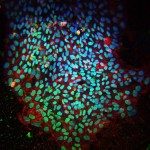Lien vers Pubmed [PMID] – 29654602
Lien DOI – 10.1111/exd.13559
Exp Dermatol 2019 Aug; 28(8): 892-898
Sagging eyelid is considered as an outward of skin ageing and may cause medical issues. However, little is known about the factors involved in sagging eyelid. The study, which aims at determining genetic risk factors for eyelid sagging, was conducted in a cohort of 502 unrelated Caucasian women living in the Paris region. All included participants were aged between 44 and 70 years old (mean age, 57.6 years old). The severity of sagging eyelid was graded in 6 categories by a dermatologist using standardized photographs of the face. A genome wide association study adjusted on potential risk factors (including age and smoking habits) was conducted to identify genetic associations. Two single nucleotide polymorphisms in total linkage disequilibrium on chromosome 10, rs16927253 (P = 7.07 × 10-10 ) and rs4746957 (P = 1.06 × 10-8 ), were significantly associated with eyelid sagging severity. The rs16927253-T and rs4746957-A alleles showed a dominant protective effect towards eyelid sagging. These polymorphisms are located in intronic parts of the H2AFY2 gene which encodes a member of the H2A histone family and very close to the AIFM2 gene that induces apoptosis. Additionally, single nucleotide polymorphisms with a false discovery rate below 0.25 were located nearby the type XIII collagen COL13A1 gene on chromosome 10 and in the ADAMTS18 gene on chromosome 16. Several relevant genes were identified by the genome wide association study for their potential role in the sagging eyelid severity.


